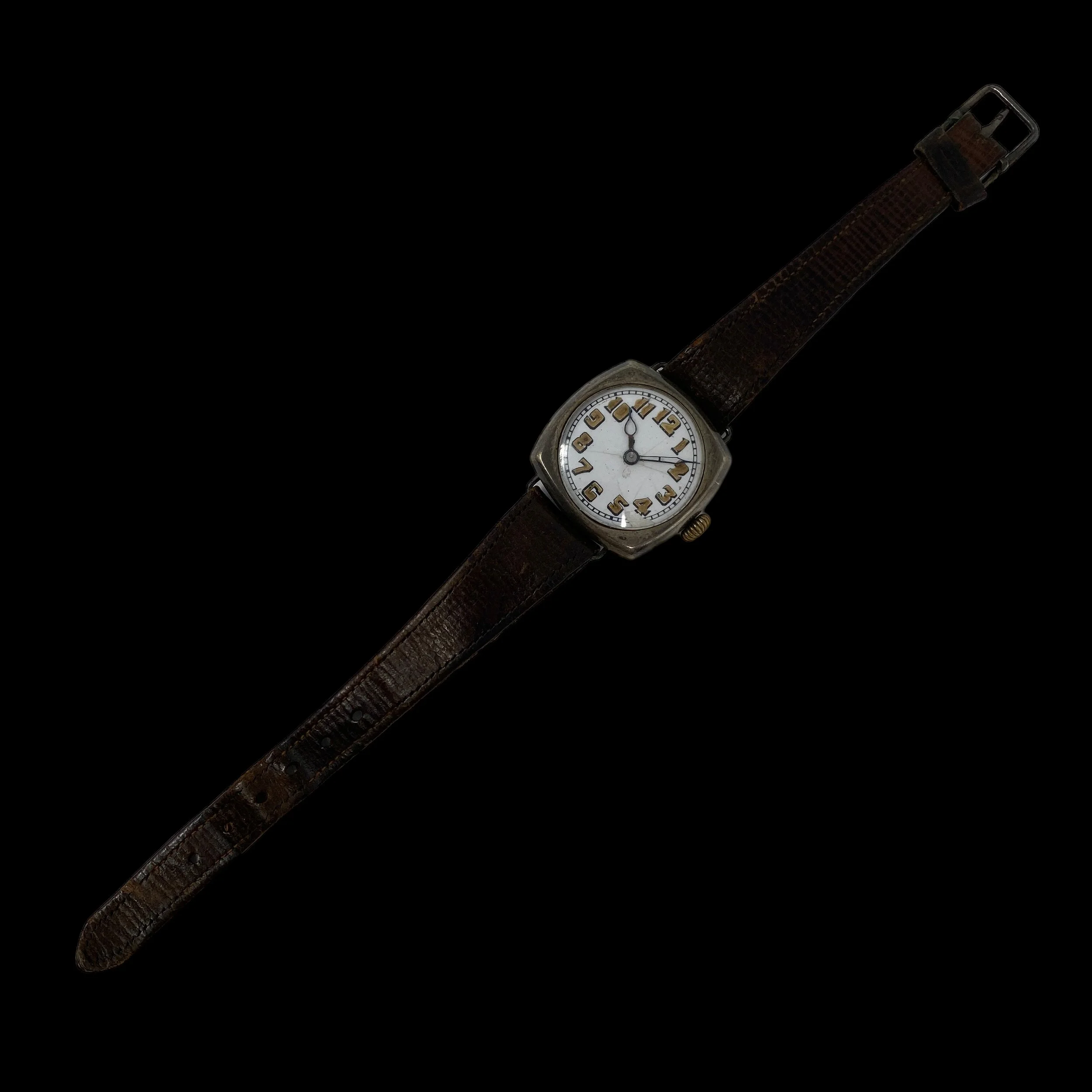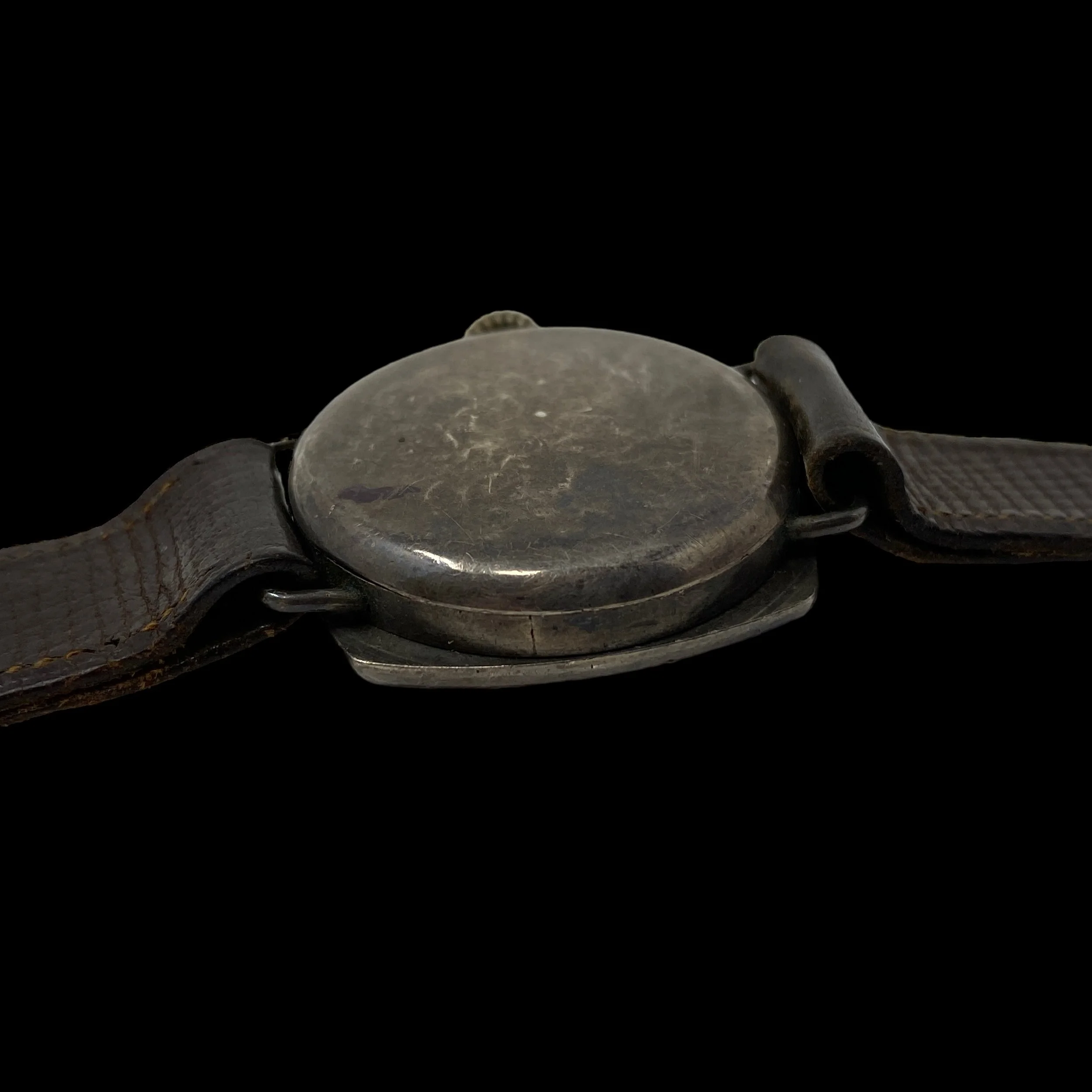VERY RARE WWI U.S. British Infantry Soldier's Great War Trench Watch with Original Leather




















VERY RARE WWI U.S. British Infantry Soldier's Great War Trench Watch with Original Leather
Comes with C.O.A.
This is an incredible and museum-grade WWI soldier’s trench watch worn in the Great War. The most important features are the luminous dial and unbreakable glass. The vitreous enamel dial has skeleton Arabic numerals and skeleton hands called “poire squelette” to take radium-based luminous paint. Unbreakable glass crystals made from celluloid were introduced in late 1915 instead of more fragile glass crystals that were vulnerable to the inevitable knocks in the cramped conditions of the trenches. What makes this original World War I trench watch even more rare and desirable is that it maintains the very rare original leather band. The inside mechanics of the watch have ceased working overtime. This could possibly be a very easy fix, however, we have not opened or tampered with in any way. It is pristine and untampered with.
During WWI these trench watches worn on the wrist of officers on the front line were used for timing and coordination of maneuvers. They were also used for timing the firing of gun batteries. But the most notable requirement for having a wristwatch in trench warfare of the Great War was to ensure that everyone was ready to attack or go "over the top" when the signal was given. Every one of the young lieutenants who blew his whistle and scrambled out of a trench to lead his company of men towards enemy fire was wearing a wristwatch; a trench watch.
The extracts from books and articles that follow show how wristwatches were used by officers as the time set for an attach approached. In Now It Can Be Told, the war correspondent Philip Gibbs related a scene during one of the battles around Hooge in Flanders, Belgium during August 1915:
“The men deployed before dawn broke, waiting for the preliminary bombardment which would smash a way for them. The officers struck matches now and then to glance at their wrist-watches, set very carefully to those of the gunners. Then our artillery burst forth with an enormous violence of shell-fire, so that the night was shattered with the tumult of it. ... The men listened and waited. As soon as the guns lengthened their fuses the infantry advance would begin.”
“Then the time came. The watch hands pointed to the second which had been given for the assault to begin, and instantly, to the tick, the guns lifted and made a curtain of fire round the Chateau of Hooge, beyond the Menin road, six hundred yards away. "Time!" The company officers blew their whistles, and there was a sudden clatter from trench-spades slung to rifle-barrels, and from men girdled with hand-grenades, as the advancing companies deployed and made their first rush forward.”
It is interesting that Gibbs says the officers had to strike matches to see their wristwatches – they evidently were not luminous watches. Luminous wristwatches were not only easier to see in the dark, the striking of a match in itself was dangerous because it might be seen by an enemy sniper. This gave rise to the habit among cigarette smokers of never lighting three cigarettes from one match because that gave time for a sniper to home in on the light and pick off the third man.
Wristwatches were also prized as spoils of war.
In Six Weeks: The Short And Gallant Life Of The British Officer In The First World War, Lewis-Stempel relates the story of Second Lieutenant Milton Riley of 8/East Lancashire Regiment who had a Company Sergeant Major with a rather dark sense of humour: “I stood on the fire-step appalled and probably wide eyed, with the inferno of an attack so near. Nearby was the sardonic CSM. In the presence of men of my platoon he said, with a nasty grin, “When we go over on the 31st, I'm going next to you Sir.” Somewhat coldly I replied, “Why sergeant-major?” Then came the punch line - “Because Sir,” he said, “I like your wrist watch!”
More info:
The Great War was the first time in British Army history that battles were conducted by generals in remote field headquarters from where they could not see the front line. Army units deployed across the vast fields of battle had difficulty communicating with headquarters. The execution of orders and coordination of maneuvers and attacks by timing was vital. Whereas in earlier conflicts a unit could time its movements visually by watching for signals or simply keeping watch on units on its flanks and advancing as they moved, in the Great War the front was too wide for these methods to be effective. Instead, the timing was used, e.g. “The attack will begin at seven-thirty ack-emma”. The phrases ack-emma and pip-emma were used for am and pm before the adoption of 24 hour time.
The importance of watches during the Great War is emphasized by the extract reproduced here from the 1916 British War Office document "Instructions for the Training of Divisions for Offensive Action." A delay of even 30 seconds in starting must be avoided, therefore watches must be synchronized. A later section of the same document gives instructions for this; "All officers must acquire the habit of checking their watches daily with the official time, which can be obtained from the Signal Service. Commanders must pay special attention to this point during training."